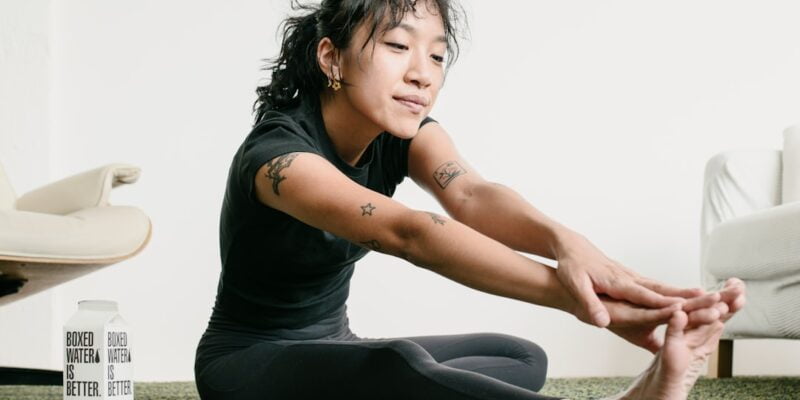
20 Morning Exercises That You Can Do At Home
Morning exercises refer to physical activities that are performed in the morning, typically before starting the day’s activities. These exercises can range from simple stretches and warm-up routines to more intense cardiovascular workouts and strength training exercises. Engaging in morning exercises has numerous benefits for both the body and mind. It helps to increase energy levels, improve mood and mental clarity, promote better sleep quality, boost metabolism and aid in weight loss, and establish consistency in an exercise routine.
Key Takeaways
- Morning exercises can help improve overall health and well-being.
- Exercising in the morning can boost energy levels and improve productivity throughout the day.
- Preparing for morning exercises at home can help save time and make it easier to stick to a routine.
- Warm-up exercises are important to prevent injury and prepare the body for more intense activity.
- Incorporating a variety of exercises, including cardiovascular, strength training, flexibility, and yoga, can provide a well-rounded workout.
Benefits of Exercising in the Morning
1. Increased energy levels throughout the day: Engaging in morning exercises helps to kickstart your metabolism and increase blood flow, which leads to a surge in energy levels. This boost in energy can help you feel more alert and focused throughout the day, allowing you to be more productive in your daily tasks.
2. Improved mood and mental clarity: Morning exercises release endorphins, which are known as “feel-good” hormones. These endorphins help to improve mood, reduce stress, and enhance mental clarity. Starting your day with exercise can set a positive tone for the rest of the day, helping you to approach challenges with a more positive mindset.
3. Better sleep quality: Regular morning exercise can help regulate your sleep-wake cycle. By engaging in physical activity early in the day, you can promote better sleep quality at night. Exercise also helps to reduce anxiety and stress, which are common culprits of sleep disturbances.
4. Increased metabolism and weight loss: Morning exercises can boost your metabolism, leading to increased calorie burn throughout the day. This can be particularly beneficial for individuals looking to lose weight or maintain a healthy weight. Additionally, exercising in the morning helps to jumpstart your metabolism, allowing you to burn calories more efficiently throughout the day.
5. Consistency in exercise routine: One of the biggest challenges when it comes to maintaining an exercise routine is finding the time and motivation to do it consistently. By incorporating morning exercises into your daily routine, you eliminate the risk of other commitments or fatigue getting in the way of your workout. This consistency can help you achieve your fitness goals more effectively.
How to Prepare for Morning Exercises at Home
1. Set a consistent wake-up time: Establishing a consistent wake-up time is crucial for incorporating morning exercises into your routine. Try to wake up at the same time every day, even on weekends, to maintain a regular sleep schedule. This will make it easier to wake up early and start your exercise routine.
2. Lay out workout clothes and equipment the night before: To make it easier to get started with your morning exercises, lay out your workout clothes and any necessary equipment the night before. This eliminates the need to search for items in the morning and helps you get into the exercise mindset as soon as you wake up.
3. Plan out workout routine ahead of time: Having a plan in place for your morning workout can help you stay focused and motivated. Decide on the type of exercises you want to do, the duration of each exercise, and any specific goals you want to achieve. This will help you stay on track and make the most of your workout time.
4. Have a healthy breakfast option ready: After completing your morning exercises, it’s important to refuel your body with a nutritious breakfast. Prepare a healthy breakfast option the night before, such as overnight oats or a smoothie, so that it’s ready to eat as soon as you finish your workout. This will ensure that you start your day with a balanced meal that provides the necessary nutrients for recovery and energy.
Warm-Up Exercises to Start Your Day
Before diving into more intense exercises, it’s important to warm up your muscles and prepare your body for physical activity. Here are some warm-up exercises that can be incorporated into your morning routine:
1. Neck rolls and shoulder shrugs: Gently roll your neck in a circular motion, first clockwise and then counterclockwise. Follow this with shoulder shrugs, lifting your shoulders up towards your ears and then relaxing them down.
2. Arm circles and wrist rotations: Extend your arms out to the sides and make small circles with your arms, gradually increasing the size of the circles. After a few repetitions, switch directions. For wrist rotations, extend your arms in front of you and rotate your wrists in a circular motion.
3. Leg swings and ankle rotations: Stand next to a wall or hold onto a stable surface for support. Swing one leg forward and backward, gradually increasing the range of motion. Repeat with the other leg. For ankle rotations, lift one foot off the ground and rotate your ankle in a circular motion. Switch directions after a few rotations.
4. Jumping jacks and high knees: Jumping jacks involve jumping while simultaneously spreading your legs apart and raising your arms overhead. High knees involve jogging in place while lifting your knees as high as possible towards your chest.
Cardiovascular Exercises for a Healthy Heart
Cardiovascular exercises are essential for maintaining a healthy heart and improving overall cardiovascular fitness. Here are some cardiovascular exercises that can be incorporated into your morning exercise routine:
1. Running or jogging in place: If you have limited space or prefer to exercise indoors, running or jogging in place is a great option. Simply lift your knees high and pump your arms as if you were running outdoors.
2. Jump rope: Jumping rope is an excellent cardiovascular exercise that can be done indoors or outdoors. It helps to improve coordination, agility, and cardiovascular endurance.
3. High-intensity interval training (HIIT): HIIT involves alternating between short bursts of high-intensity exercise and periods of rest or low-intensity exercise. This type of workout is highly effective for burning calories and improving cardiovascular fitness.
4. Cycling or stationary bike: If you have access to a stationary bike or a regular bicycle, cycling is a low-impact cardiovascular exercise that can be done indoors or outdoors. It helps to strengthen the lower body muscles and improve cardiovascular endurance.
Strength Training Exercises for Toned Muscles
Strength training exercises are important for building and toning muscles, improving bone density, and boosting metabolism. Here are some strength training exercises that can be incorporated into your morning exercise routine:
1. Push-ups and planks: Push-ups target the chest, shoulders, triceps, and core muscles. Planks are excellent for strengthening the core muscles. Start with modified push-ups or planks on your knees if you’re a beginner.
2. Squats and lunges: Squats target the muscles of the lower body, including the quadriceps, hamstrings, and glutes. Lunges also work the lower body muscles and help improve balance and stability.
3. Dumbbell curls and shoulder presses: Dumbbell curls target the biceps, while shoulder presses target the deltoids and triceps. Use light dumbbells to start and gradually increase the weight as you get stronger.
4. Resistance band exercises: Resistance bands are versatile and can be used to target various muscle groups. They provide resistance throughout the entire range of motion, helping to build strength and muscle tone.
Flexibility Exercises for Improved Mobility
Flexibility exercises are important for maintaining joint mobility, preventing injuries, and improving overall flexibility. Here are some flexibility exercises that can be incorporated into your morning exercise routine:
1. Standing hamstring stretch: Stand with your feet hip-width apart and extend one leg forward while keeping it straight. Bend forward from your hips and reach towards your toes, feeling a stretch in the back of your leg. Hold for 20-30 seconds and repeat on the other leg.
2. Seated spinal twist: Sit on the floor with your legs extended in front of you. Bend one knee and place the foot on the outside of the opposite knee. Twist your torso towards the bent knee, placing your opposite elbow on the outside of the bent knee. Hold for 20-30 seconds and repeat on the other side.
3. Butterfly stretch: Sit on the floor with the soles of your feet together and your knees bent out to the sides. Hold onto your ankles or feet and gently press your knees towards the floor. Feel a stretch in your inner thighs and hold for 20-30 seconds.
4. Downward-facing dog: Start in a push-up position and lift your hips up towards the ceiling, forming an inverted V shape with your body. Press your heels towards the ground and feel a stretch in your calves, hamstrings, and back. Hold for 20-30 seconds.
Yoga Poses for a Calm and Focused Mind
Yoga poses not only improve flexibility but also promote relaxation, calmness, and mental focus. Here are some yoga poses that can be incorporated into your morning exercise routine:
1. Child’s pose: Kneel on the floor with your knees hip-width apart and sit back on your heels. Extend your arms forward and rest your forehead on the mat or a cushion. Breathe deeply and hold for 30-60 seconds.
2. Mountain pose: Stand tall with your feet hip-width apart and arms by your sides. Engage your core muscles, lengthen your spine, and relax your shoulders. Breathe deeply and hold for 30-60 seconds.
3. Warrior II pose: Stand with your feet wide apart, facing forward. Turn one foot out to the side and bend that knee, keeping it directly over the ankle. Extend your arms out to the sides at shoulder height, palms facing down. Look over your front hand and hold for 30-60 seconds. Repeat on the other side.
4. Tree pose: Stand tall with your feet together and arms by your sides. Shift your weight onto one foot and lift the other foot off the ground, placing the sole of the foot against the inner thigh or calf of the standing leg. Bring your hands together in front of your chest or extend them overhead. Breathe deeply and hold for 30-60 seconds. Repeat on the other side.
Low-Impact Exercises for Beginners
If you’re new to exercise or have joint issues, low-impact exercises are a great option to start with. Here are some low-impact exercises that can be incorporated into your morning exercise routine:
1. Walking or light jogging: Walking is a simple and effective way to get moving in the morning. If you’re looking for a slightly higher intensity, you can incorporate light jogging intervals into your walk.
2. Swimming or water aerobics: Swimming is a low-impact exercise that provides a full-body workout. If you have access to a pool, consider swimming laps or participating in water aerobics classes.
3. Yoga or Pilates: Both yoga and Pilates are low-impact exercises that focus on strength, flexibility, and balance. They can be done at home using online videos or by attending a class.
4. Tai chi or qigong: Tai chi and qigong are ancient Chinese practices that involve slow, flowing movements and deep breathing. They are gentle on the joints and help improve balance, flexibility, and overall well-being.
Cool-Down Exercises to End Your Morning Workout Session
After completing your morning workout, it’s important to cool down and allow your body to gradually return to its resting state. Here are some cool-down exercises that can be incorporated into your morning exercise routine:
1. Walking or slow jogging: After completing your workout, spend a few minutes walking or slow jogging to gradually lower your heart rate and cool down your body.
2. Stretching exercises for all major muscle groups: Perform static stretches for all major muscle groups, holding each stretch for 20-30 seconds. Focus on stretching the muscles that were worked during your workout.
3. Deep breathing exercises: Sit or lie down in a comfortable position and take slow, deep breaths. Inhale deeply through your nose, filling your lungs with air, and exhale slowly through your mouth. This helps to relax the body and promote a sense of calm.
4. Meditation or mindfulness practice: Spend a few minutes practicing meditation or mindfulness to end your morning workout session. This can help you feel centered, focused, and ready to tackle the day ahead.
Incorporating morning exercises into your daily routine can have numerous benefits for both the body and mind. From increased energy levels and improved mood to better sleep quality and weight loss, there are plenty of reasons to start your day with exercise. By following a few simple steps to prepare for morning exercises at home, you can set yourself up for success and make it easier to stick to a consistent routine. Whether you choose to focus on cardiovascular exercises, strength training, flexibility exercises, or low-impact workouts, there are plenty of options to suit your preferences and fitness level. So why not start tomorrow morning with a workout that will leave you feeling energized, focused, and ready to take on the day?
Looking for more fitness inspiration? Check out this informative article on Wave Magnets’ website that provides a comprehensive guide to morning exercises you can do at home. From simple stretches to full-body workouts, these exercises are designed to help you kickstart your day with energy and vitality. Whether you’re a beginner or an experienced fitness enthusiast, this article offers a variety of exercises to suit your needs. Don’t miss out on this valuable resource! Click here to read the article and start your morning routine today.
FAQs
What are morning exercises?
Morning exercises are physical activities that are performed in the morning to help improve physical fitness, boost energy levels, and promote overall health and well-being.
Why should I do morning exercises?
Morning exercises can help you start your day on a positive note, improve your mood, increase your metabolism, and enhance your overall physical and mental health.
What are some examples of morning exercises?
Some examples of morning exercises include stretching, yoga, jogging, jumping jacks, push-ups, squats, lunges, and planks.
Can I do morning exercises at home?
Yes, you can do morning exercises at home. In fact, there are many exercises that you can do at home without any equipment.
How long should I do morning exercises?
The duration of your morning exercise routine will depend on your fitness level and goals. However, it is recommended to start with a 10-15 minute routine and gradually increase the duration as you become more comfortable.
What are the benefits of doing morning exercises?
Some benefits of doing morning exercises include improved physical fitness, increased energy levels, better mood, enhanced mental clarity, and reduced stress levels.
Do I need any equipment to do morning exercises?
No, you do not need any equipment to do morning exercises. However, you may choose to use equipment such as dumbbells or resistance bands to add variety and intensity to your routine.
Can morning exercises help me lose weight?
Yes, morning exercises can help you lose weight by increasing your metabolism and burning calories. However, it is important to combine exercise with a healthy diet for optimal weight loss results.


















